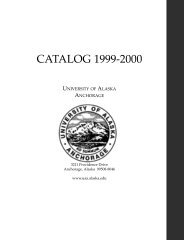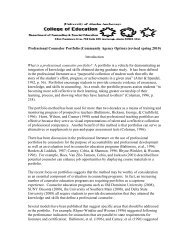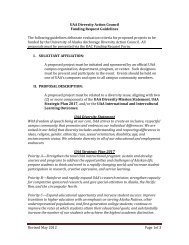UNIVERSITY OF ALASKA ANCHORAGE
UNIVERSITY OF ALASKA ANCHORAGE
UNIVERSITY OF ALASKA ANCHORAGE
Create successful ePaper yourself
Turn your PDF publications into a flip-book with our unique Google optimized e-Paper software.
A R C H E O L O G I C A L<br />
B R E A K T H R O U G H<br />
Crossen presented the paper at the annual Geological Society of<br />
The main question is why mammoths survived out there so long,<br />
America meeting in Salt Lake City in October 2005.<br />
he said.<br />
Qagnax Cave was discovered in 1999 by residents of St. Paul<br />
The chamber is 53 feet underground located in a lava tube about<br />
Island, one of five islands comprising the volcanic Pribilof Island group<br />
49 feet wide and 39 feet high, which made it a natural trap for<br />
in the eastern Bering Sea.The islands are the most remote in North<br />
animals, including mammoth, polar bear, caribou or reindeer and<br />
America.<br />
Arctic fox.<br />
People riding four-wheelers found the entrance to the site when<br />
“Once you got in you couldn’t get out,” Crossen said.<br />
their vehicles nearly fell into the hole,Veltre said.<br />
Many of the 1,250 bones recovered from fox, caribou, polar bears,<br />
“You can’t really see it from any distance,” he said.<br />
birds and at least one mammoth show evidence of being chewed on<br />
Locals went down into the tube and sent a photo of a polar bear<br />
by other animals – including chewed areas and tooth puncture holes.<br />
tooth.When Veltre visited the cave he returned with a<br />
Researchers concluded that the cave acted as a natural trap into<br />
mammoth tooth.<br />
which animals fell, some still alive, to consume bones and possibly the<br />
carcasses of previously trapped animals.<br />
The research project focused on reconstructing the geologic<br />
context, photographing and mapping the cave and the faunal remains,<br />
collecting the bones, testing the central debris cone, and dating the<br />
mammoth remains.The cleaned and dried materials are currently<br />
housed at the UAA Anthropology Laboratory.<br />
The dig was funded by a Faculty Development Grant from UAA<br />
and the TDX Corp. of St. Paul. TDX, the Aleut village corporation of<br />
St. Paul, gave permission for fieldwork and analysis, as well as in-kind<br />
support for a research project that began in 2003.<br />
UAA Archeologists explore the<br />
site of the mammoth discovery,<br />
Qagnax Cave on St. Paul Island<br />
Researchers brought back more than 100 bags of bones from the<br />
cave floor, Crossen said.<br />
Mammoth tusks have been found on St. Paul for a long time –<br />
including one tusk in the Smithsonian’s collections dated to about<br />
8,000 years ago – but no tusks were found among the mammoth<br />
bones and fragments recovered.<br />
W<br />
oolly mammoth remains found in a lava tube cave<br />
53 feet below the surface of St. Paul island have been dated<br />
to about 5,700 years ago.That s at least 2,200 years<br />
The assumption is that previous cave explorers removed some of<br />
the materials, Crossen said.<br />
There’s not much left in the cave now, she said.<br />
younger than any previously dated mammoth remains found in<br />
“We basically took all of the bones on the ground that we could<br />
North America.<br />
see,” Veltre said.<br />
New evidence suggests that the survival of isolated woolly<br />
Crossen said “I felt bad walking anywhere down there because I<br />
Gee, that’s a funny looking tooth<br />
While they may be a little funny looking, the<br />
woolly mammoth s ridged molars are actually<br />
highly specialized to break down the relatively<br />
tough, dry grasses they ate.<br />
Over time, as these teeth wore, the enamel<br />
ridges stood out and worked like grinding mills.<br />
Like modern elephants, six molar-like teeth<br />
developed on each side of the jaw during a<br />
lifetime. But due to the limited space in their<br />
mouths, mammoths used only two pairs of<br />
molars at a time.<br />
Successive teeth grew forward from the back<br />
of the jaw replacing earlier, smaller teeth as they<br />
wore, moved forward, and dropped.<br />
mammoths on the Pribilof Islands may be closely related to the<br />
absence of human habitation on the islands until the late 18th<br />
century when the Russians brought Aleuts there as forced labor in<br />
the harvest of fur seals, according to research by UAA s Douglas<br />
Veltre, Kristine Crossen, David Yesner, and Penn State s<br />
Russell Graham.<br />
The location of Qagnax Cave — in the Pribilof Islands, 310 miles<br />
off the coast of mainland Alaska — makes it an excellent test case in<br />
support of the idea that mammoths most likely survived longer in<br />
areas without human occupation, researchers wrote in a paper titled<br />
Last Outpost of North American Mammoths Found on Isolated<br />
Alaskan Island.<br />
Yesner said he kept walking by the mammoth tooth sitting on<br />
Veltre’s desk. And thinking about the late human occupation of<br />
St. Paul.<br />
That makes the islands a good test case for the idea that<br />
mammoths survived later in areas not occupied by humans. On<br />
Wrangel Island off the north coast of Siberia, for instance, mammoths<br />
survived until about 4,000 years ago.<br />
“The first dates for human and the last mammoth dates are very<br />
close,” Yesner said.<br />
knew I was destroying things.”<br />
Researchers said the cave’s cool temperatures year-round<br />
contributed to the preservation of the bones and make them good<br />
candidates for radio carbon dating and DNA testing.<br />
“There were foxes curled up in the corner with their fur still on<br />
them,” Crossen said.<br />
The dates from the mammoth bones tested are so close they may<br />
all be from the same animal; all at least 2,200 years younger than any<br />
previously dated mammoth remains found in North America.<br />
Yesner said there also is some funding to radio carbon date some of<br />
the caribou bones to see if they are from the original herds that<br />
roamed Alaska or the herds of reindeer that were introduced later.<br />
12 Accolades<br />
Accolades 13
















